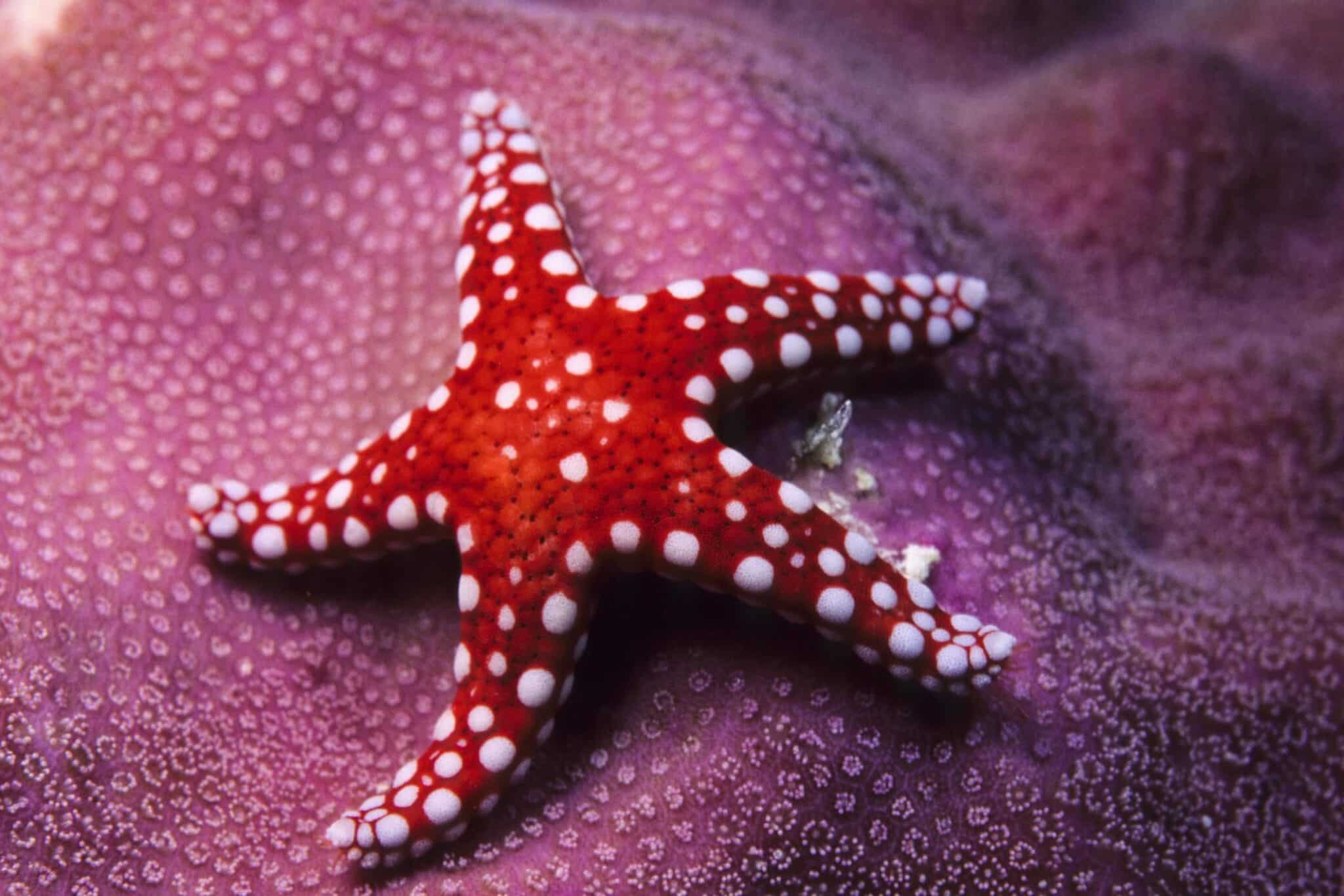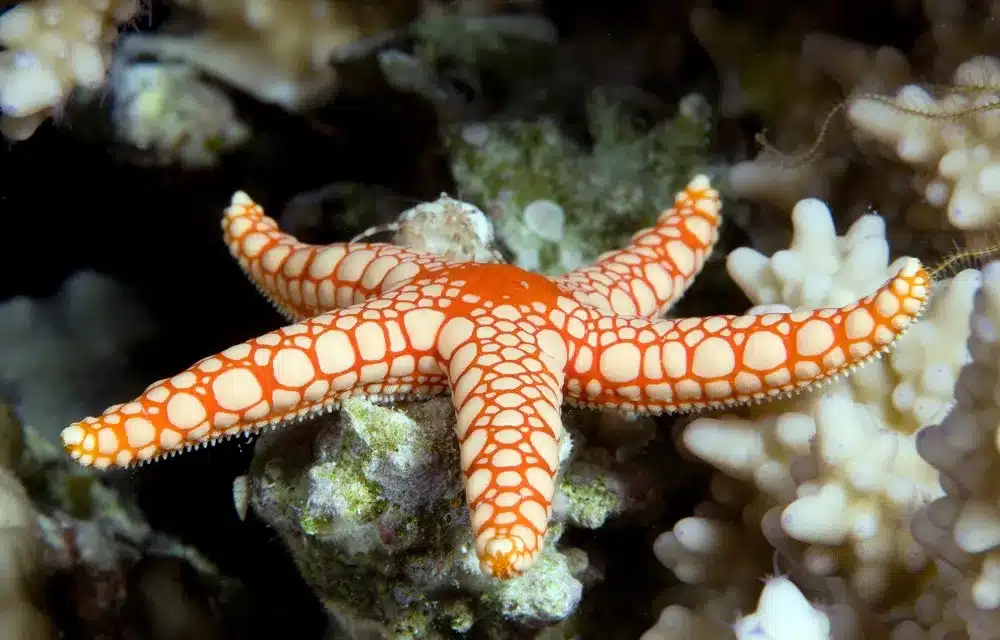Where Are The Eyespots On A Starfish

Introduction
Where Are The Eyespots On A Starfish: Starfish, fascinating marine creatures known for their radial symmetry and unique characteristics, possess a remarkable sensory adaptation in the form of eyespots. However, it’s important to note that these eyespots are quite different from the complex eyes found in many other animals.
Starfish eyespots are not clustered in one central location but are distributed throughout their bodies. These eyespots are found at the tip of each of the starfish’s eyes and arms, often numbering between one and three per arm, depending on the species. They are simple photoreceptor organs, meaning they can detect light and dark but do not form detailed images. Consequently, starfish have a limited ability to perceive their surroundings visually.
These rudimentary eyespots serve a crucial function in helping starfish navigate their environment. They can detect changes in light, which is particularly useful for identifying potential predators or locating prey. When a shadow passes over them or when they move into a darker area, the eyespots signal to the starfish to change direction or seek shelter.
Despite their limited visual capabilities, starfish are remarkably adapted to their underwater habitats. Their eyespots, although basic, play a vital role in their survival and exemplify nature’s ability to craft specialized solutions to the challenges of the marine world.

Can starfish see from their eyespots?
Although starfish cannot detect small visual details, the placement of an eye on each arm gives them a large visual field. They can see large unmoving or slowly moving structures, such as the coral reefs that are their homes.
Starfish have eyespots, but their visual capabilities differ significantly from those of more complex animals with well-developed eyes. Starfish eyespots do not enable them to see in the way humans or many other animals do.
Starfish eyespots are simple photoreceptor organs that can detect changes in light and darkness. They essentially function like light sensors, allowing starfish to perceive variations in light intensity. These eyespots are found at the tips of each of the starfish’s arms and are sensitive to the surrounding light conditions.
However, starfish do not have the ability to form detailed images or see shapes and colors as humans do. Their eyespots are primarily used to detect shadows, which can be helpful in identifying potential predators or finding prey. When a shadow passes over them or when they move into a darker area, the eyespots signal to the starfish to change direction or seek shelter.
Starfish can detect changes in light using their eyespots, but they do not have true vision in the way we understand it. Their eyespots serve a basic sensory function, allowing them to navigate their environment and respond to changes in light conditions, which is essential for their survival in the underwater world.
Do starfish have eyes on each leg?
Starfish have eyes—one on the end of each of their arms—but what they do with them was anyone’s guess.
Starfish, also known as sea stars, do not have eyes on each leg, but they have a simple visual sensory structure called eyespots located at the tip of each of their arms. These eyespots are quite basic and differ significantly from the complex eyes found in many other animals.
The eyespots of starfish serve a limited sensory function. They can detect changes in light and darkness but cannot form detailed images or provide detailed vision. Essentially, these eyespots function as light sensors, helping the starfish perceive variations in light intensity in their environment.
The number of eyespots on a starfish can vary depending on the species, but typically there is one to three eyespots on each arm. These eyespots play a crucial role in helping starfish navigate their surroundings. When a shadow passes over them or when they move into a darker area, the eyespots can detect these changes and signal the starfish to react accordingly. This might involve changing direction to avoid a potential threat or moving towards a source of food.
Starfish do not have eyes on each leg, but they do have eyespots at the tip of each arm that allow them to perceive changes in light and darkness, helping them with basic navigation and survival in their underwater habitats.
What is the white spot on a starfish?
However, a natural part of sea star anatomy is the white spot at the center of the sea star – this is the madreporite. The Madreporite is an opening that sucks in water to help with movement, feeding, and respiration. Also, when see stars spawn, there will be white goop near the madreporite – which is totally normal.
The white spot on a starfish is often a point of curiosity and sometimes confusion. It’s important to note that not all starfish have a white spot, and the presence or absence of such a spot can vary among different species.
The white spot you might observe on a starfish is not an eye or an eyespot but rather a specialized structure known as a madreporite. The madreporite is a small, round, or oval-shaped plate located on the upper surface of a starfish, usually near the center. It appears as a raised, whitish or light-colored area that might stand out against the starfish’s typically rough and textured skin.
The primary function of the madreporite is to regulate the starfish’s water vascular system. This system is crucial for the starfish’s movement and feeding. Through the madreporite, the starfish draws in seawater, which is then circulated throughout its body to operate its tube feet, which help it move, capture prey, and exchange gases.
In essence, the madreporite is a key anatomical feature for the starfish’s hydraulic locomotion and survival, but it is not related to vision or eyesight in any way. Instead, as a part of the starfish’s remarkable adaptation to its underwater environment, it facilitates essential bodily functions related to mobility and feeding.
How many eyes has a starfish get?
Sea Stars Have Eyes
It’s true. The eyes are there—just not in the place you would expect. Sea stars have an eye spot at the end of each arm. This means that a five-armed sea star has five eyes, while the 40-armed sun star has 40 eyes.
Starfish, also known as sea stars, do not have true eyes like humans or many other animals. Instead, they have simple sensory structures called eyespots, and the number of these eyespots can vary depending on the species.
Typically, a starfish has one to three eyespots on each of its arms. These eyespots are small, pigmented areas located at the tip of each arm. They are simple photoreceptor organs that can detect changes in light and darkness in their environment.
However, it’s important to understand that starfish eyespots are quite basic and do not provide detailed vision. They do not allow starfish to see shapes, colors, or fine details like complex eyes do. Instead, these eyespots function more like light sensors, helping starfish perceive variations in light intensity.
The distribution of eyespots throughout a starfish’s arms gives it a broad awareness of its surroundings. This is particularly useful for detecting changes in light that might signal the presence of potential threats or sources of food. When a shadow passes over them or when they move into a darker area, the eyespots help the starfish respond to these changes and adjust its behavior.
Starfish have multiple eyespots, typically one to three on each arm, which serve as basic light-detecting sensory organs rather than fully developed eyes for vision.
Where would you find the eyespot on the sea star and what is its function?
The arms are covered with pincerlike organs and suckers that allow the animal to slowly creep along the ocean floor. Light-sensitive eyespots on the tips of the arms help the sea star find food.
The eyespot on a sea star (commonly known as a starfish) is typically located at the tip of each of its arms. These eyespots are small, round, or oval-shaped pigmented structures that may appear as dark or light spots depending on the species. The primary function of these eyespots is to detect changes in light and darkness in the surrounding environment.
However, it’s important to note that sea star eyespots are relatively simple and do not provide detailed vision like human eyes or the eyes of more advanced animals. Instead, sea star eyespots serve as basic photoreceptor organs. They can detect variations in light intensity, allowing the sea star to perceive changes in its surroundings. This is particularly valuable for the following purposes:
- Predator Avoidance: Sea stars can use their eyespots to detect the shadow of a potential predator looming over them. When they sense such a change in light, they may react by moving away or seeking shelter.
- Locating Prey: Sea stars are opportunistic feeders, and their eyespots can help them detect the presence of prey, such as small crustaceans or mollusks. They can move toward areas with changing light patterns that might indicate potential sources of food.
- Navigation: Eyespots assist sea stars in basic navigation as they move across the ocean floor or other underwater surfaces. Detecting changes in light can help them orient themselves or adjust their direction.
The eyespots on a sea star’s arms are rudimentary sensory organs that detect changes in light and darkness. Their primary function is to assist with predator avoidance, locating prey, and basic navigation in the underwater environment, enhancing the sea star’s chances of survival.
Can starfish see color with their eyespots?
Starfish cannot see in color with their eyespots. They primarily perceive changes in light and darkness but lack the specialized cells required for color vision. Their eyespots are adapted for basic orientation rather than detailed visual information.
Starfish cannot see color with their eyespots. Starfish eyespots are extremely basic and lack the ability to perceive color or form detailed images. They are primarily sensitive to changes in light and darkness in their environment.
The eyespots of a starfish are simple photoreceptor organs that can detect variations in light intensity. They function somewhat like light sensors, allowing starfish to perceive differences in illumination. However, they lack the specialized cells and structures necessary for color vision.
Color vision typically requires the presence of specialized pigments and photoreceptor cells known as cones, which are found in the eyes of animals like humans and some birds. Cones enable these animals to perceive a wide range of colors by detecting different wavelengths of light.
In contrast, starfish eyespots are more primitive and serve a more basic purpose. They help starfish detect changes in light, which can be valuable for tasks like predator avoidance, locating prey, and basic navigation in their underwater habitats. However, their visual capabilities are limited to distinguishing light from dark and do not extend to recognizing or perceiving colors.
Do all starfish have the same number of eyespots?
The number of eyespots can vary among starfish species. Some may have a single eyespot per arm, resulting in five eyespots, while others may have multiple eyespots per arm. The size, complexity, and sensitivity of eyespots can also differ.
The number of eyespots on a starfish can vary depending on the species, and it’s not a consistent characteristic among all members of the starfish family.
Typically, a starfish has one to three eyespots on each of its arms. However, this can differ between species, and some starfish may have more or fewer eyespots. The distribution and arrangement of these eyespots can also vary.
The variation in the number and arrangement of eyespots is related to the specific ecological and environmental needs of different starfish species. Some species may have more eyespots to enhance their ability to detect changes in light and shadows, while others may have fewer but larger eyespots, which might serve a similar purpose.
It’s important to note that starfish eyespots are relatively simple and do not provide detailed vision like complex eyes. They primarily function as basic light sensors, helping starfish perceive variations in light intensity in their surroundings. This helps them with tasks such as predator avoidance, locating prey, and basic navigation.
So, while the number and arrangement of eyespots may vary among different starfish species, the fundamental function of these eyespots remains consistent in assisting with the starfish’s survival and adaptation to its underwater habitat.
Can starfish regenerate lost eyespots?
Starfish are known for their impressive regenerative abilities, but the capacity to regenerate eyespots may vary among species. In some cases, they may regenerate lost eyespots over time, but the process can be slow and may not always result in complete restoration.
Starfish cannot regenerate lost eyespots. Unlike some other parts of their bodies, such as arms, which they can regenerate, once a starfish loses an eyespot, it cannot regrow or replace it.
Starfish are known for their remarkable regenerative abilities, and they can regenerate lost arms, sometimes even an entire new starfish can grow from a single arm. However, the eyespots are specialised structures that are not among the body parts that starfish can regenerate.
The eyespots of a starfish are relatively simple photoreceptor organs that detect changes in light and darkness. They serve essential sensory functions, such as helping the starfish navigate its environment, locate prey, and avoid predators. While these eyespots are vital for the starfish’s survival, they do not possess the regenerative capabilities seen in some other body parts.
So, if a starfish loses an eyespot due to injury or other reasons, it cannot replace or regenerate it. The starfish will continue to function with the remaining eyespots on its arms, but the lost eyespot will not be restored.

Conclusion
The distribution of eyespots on a starfish’s arms is a testament to the incredible adaptability of marine life. While these photoreceptor organs may seem rudimentary compared to the eyes of more advanced animals, they are perfectly suited to the starfish’s needs.
The decentralised arrangement of eyespots allows starfish to have a broad awareness of their surroundings. This simple visual system helps them detect changes in light, which is essential for their survival in the underwater world. Whether it’s identifying potential threats or locating sources of food, these eyespots are instrumental in guiding the starfish’s movements.
In the grand tapestry of marine life, the starfish’s eyespots may be modest, but they are a testament to the beauty of evolution and adaptation. They remind us that even the simplest of organs can be perfectly suited to an organism’s specific needs, and in the case of the starfish, these eyespots are vital tools for navigating the complex and ever-changing underwater world.



